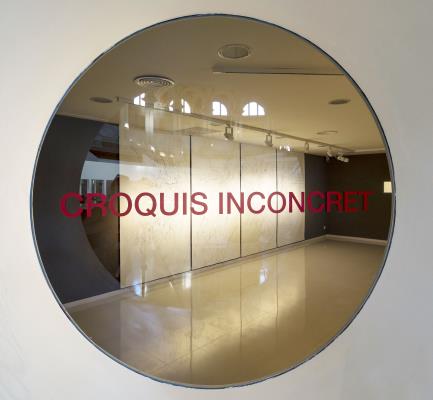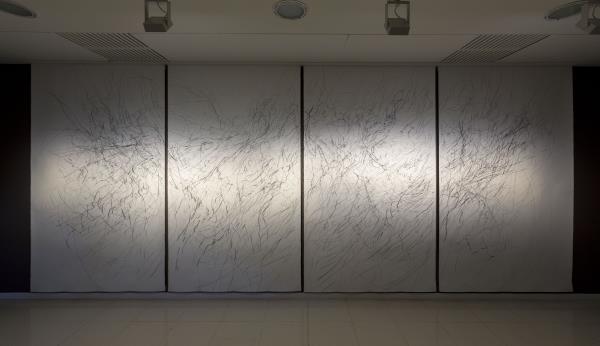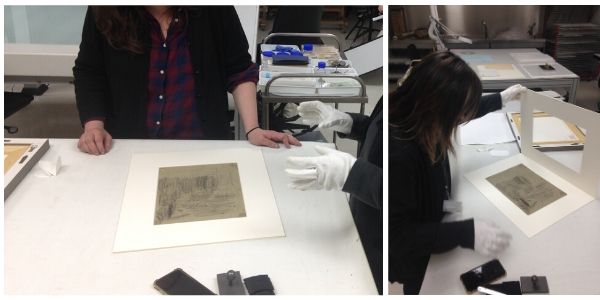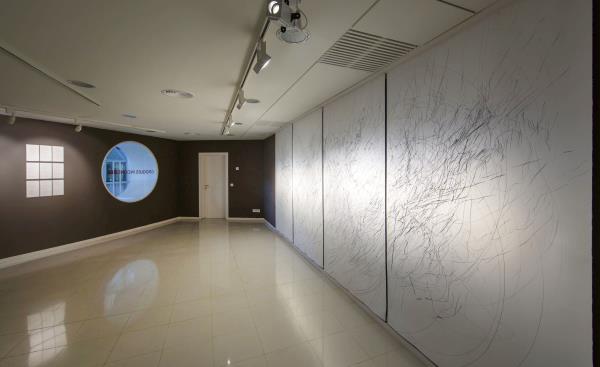Èlia Llach

To prepare this project, the artist Èlia Llach (Barcelona, 1976) consulted the collection of the museum’s Cabinet of Drawings and Prints several times. There, what most caught her eye were some drawings by the painter Marià Fortuny (Reus, 1838 –Rome, 1874) classified as ‘Vague Sketches’, an apparently contradictory title referring to sketches that are hard to identify.

The nature of these works connected directly with the artist’s interests and with her drawing, materialized in the Espai EducArt in a large-format work in which thoughts, words and lines are mixed up.
Èlia Llach’s gesture stretches as far as the museum’s collection: in the Modern Art Collection (room 51), the artist asked us to turn a drawing by Fortuny back to front to show the vague sketch on the back; a back that is never on view to the public and which can now be contemplated.

In the Espai educArt there is a drawing on display in which Èlia’s gesture breaks free and is celebrated on four large sheets of paper. It is accompanied by a poem by Wallace Stevens, a text by María Zambrano and a series of reproductions of Vague Sketches by Marià Fortuny together with a hand-written text by the artist herself, notes that put words to her work, to her thoughts, and which we reproduce here.


Croquis inconcret (Unidentifiable skecth), by Èlia Llach can be seen in the Museu Nacional’s Espai educArt until 10 January 2021.
Unidentifiable sketch. Notebook
(…) We fall into the trap in which looking is an action of the eyes that verify what is real or appears to be: perhaps I should draw without the word, the image or the place mattering. I draw.
I closed my eyes and held my breath as long as I could. Opening my eyes suddenly and at the same time taking a deep breath, as if discovering anew. I draw.
We have all too soon become accustomed to big headlines and we do not even doubt them. Not even our hand dares to touch them. I draw.
What is the concern of the drawing and of the image. What image? Is the image appearance or resemblance to something? I have been thinking about the latent for days. It seems to be flying over me, tempting me, closer sometimes than at others. The latent image is that which is waiting to be revealed. The drawing also waits to be revealed. How to go from the latent image to the visible image? It could be a trick question. Never before have I felt the joy of the image so close. I draw.
I am incapable of achieving what I ought to see. In the case of being something known it seems to be out of place. The lines, the marks, are drawn on the non-existent place of a blank sheet of paper on which the gesture opens up without the meaning mattering yet. What we are looking for has disappeared. What we are looking for is laughing at us. I draw.
In its defiance … Is drawing acting when desire becomes action? Is drawing what is happening? I draw.
We ought to return the gesture to what is the gesture’s and forget about words. We ask ourselves for words. I have no words. I draw.
I am fascinated by images that disappear, those that are erased before my eyes, those that leave some trace. Why don’t we allow images that wish to disappear to be erased? We should let them go. The gesture sometimes announces itself by being erased. I draw.
Croquis (sketch), from the French: a quick drawing that describes the essential features of the subject or the motif. The word croquis hit isolated peaks of usage in the years 1809, 1871, 1907 and 1933 almost at the same time as different wars. Since then its use has been in decline although it is fighting back. I draw.
If we give a name to things it may be more difficult to lose them but it is perhaps a mistake to give the image a specific name. Is drawing on a blank sheet therefore not an opening gesture? I draw.
What is the question about these drawings? What are they or what is their challenge? Words interfere with the gesture. Words are pointless because the drawing only is when nothing has yet made sense. I draw.
Trying to draw conquering the unknown. Line by line, stripping myself bare of words. Thoughts accumulate when I stop drawing. Thoughts want to be words but drawing demands continuing without being interrupted like the hunter who pursues the prey without following any specific path. And if drawing was merely hunting? I now imagine the birds returning silently to the trees. I draw.
Do I really have to talk about drawing? Do I have to take into account from where we look? Great drawings are never done from memory. I draw.
Coming and going from one drawing to another. There is something that definitively escapes me like someone singing a song to herself that she doesn’t quite know. I draw.
Without reference, memory fails. “But then the blind wings of the night descend, they fall and weigh heavily, being wings, on he who lives anchored to the ground”, says María Zambrano. I draw.
I draw without reaching conclusions in a futile attempt to remember what that which I do not remember could be. I draw.
“Reality is a void”, says Wallace Stevens.
I draw.
(…)
List of works exhibited in Espai EducArt
Croquis inconcret (Vague Sketch). Mixed technique on paper. 5.6 x 2.4 m
Quadern de notes (Notebook). Polyptych. 2.94 x 0.3 m (Reproductions of drawings by Marià Fortuny entitled “Croquis Inconcret”. Variable sizes)
La visión – La llama (The Vision – the Flame) Chapter from the book “Claros del Bosque” by María Zambrano. Mercedes Gómez Blesa, Ed. Ediciones Cátedra. Madrid, 2011
Descripció sense lloc (Description Without Place). Polyptych. Print of the poem by Wallace Stevens entitled Description Without Place. Translated by D. Sam Abrams from the book “The Collected Poems of Wallace Stevens: Corrected Edition”. John N. Serio and Chris Beyers, Ed. Vintage Books. New York, 2015
Artista








One comment
Arte maravilhosa para aguçar a imaginação. Parabéns!